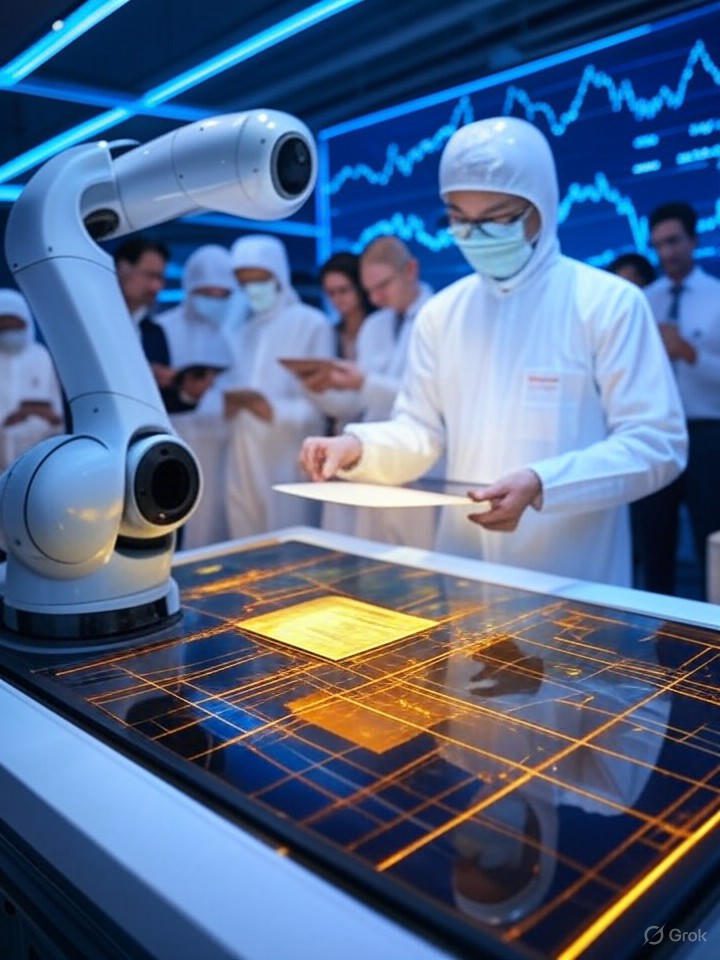The digital world, for all its boundless promise and captivating innovations, always comes back to something decidedly physical: the humble, yet incredibly complex, semiconductor chip. Right now, it feels like we’re in the midst of another Silicon Gold Rush, and this time, the pickaxes are firmly aimed at AI. There’s a palpable buzz, an almost feverish excitement, as investment pours back into the chip industry, specifically into the silicon sinews that power our Artificial Intelligence ambitions. But, and it’s a rather significant ‘but’, not everyone is finding their pot of gold at the end of this rainbow.
The AI Gold Rush: Who’s Digging and Who’s Not?
You hear the whispers, then the shouts: AI is transforming everything. And it’s true, in many ways. But to perform its astounding feats, AI needs serious horsepower – the kind that only cutting-edge semiconductors can provide. We’re talking about those incredibly powerful Graphics Processing Units (GPUs) and the High Bandwidth Memory (HBM) that feeds them data at breakneck speeds. This insatiable demand has ignited a spectacular rebound in capital expenditure across the semiconductor sector. After a rather lacklustre 2023, where investments dipped, 2024 is shaping up to be a different beast entirely. Industry forecasts, such as those reported by Nikkei, suggest that global semiconductor equipment investment is poised for a significant uplift in 2024, projected to reach around $100 billion, up from an estimated $91.2 billion in 2023, marking an increase of approximately 9.5%. We’re talking about serious money flowing into new foundries and advanced manufacturing lines.
And who’s really winning? Taiwan Semiconductor Manufacturing Company (TSMC), of course. They are, quite simply, the unsung heroes, the quiet enablers of the AI revolution. When the likes of Nvidia design their world-beating AI chips, it’s TSMC that turns those designs into tangible silicon. Their advanced process technology is a bottleneck in the best possible sense – everyone needs it, and very few can offer it. They’re projecting their own capital expenditure to remain robust, likely in the range of $28 billion to $32 billion for the year, showing sustained confidence in the long-term demand for their high-end fabrication services.
The Uneven Playing Field: A K-Shaped Recovery?
But hold on a minute, not everyone in this sprawling, interconnected industry is popping the champagne corks. While the AI segment is absolutely booming, experiencing what feels like a boom cycle akin to the dot-com era, other parts of the semiconductor market are still treading water, or worse, sinking. Think about the memory chip sector – DRAM and NAND flash. These were hit hard by oversupply and a slowdown in consumer electronics demand last year. While there are signs of recovery, it’s certainly not the explosive growth seen in AI-related components.
This creates a rather stark ‘K-shaped recovery’. On one arm of the ‘K’, you have the AI chip titans and their direct suppliers, ascending rapidly with surging revenues and investments. On the other arm, you have the more traditional chipmakers, those focused on general computing, automotive, or less advanced memory, struggling to regain momentum. They’re caught in a holding pattern, hoping the rising tide of AI will eventually lift all boats, but for now, it feels like only the super-yachts are moving swiftly. Smaller players, perhaps without the capital or the technological edge to pivot to AI, are finding themselves in an increasingly challenging position, potentially facing consolidation or even irrelevance.
Billions on the Table: What the Numbers Say
The sheer scale of investment speaks volumes. After a significant downturn in 2023, which saw capital expenditure across the industry drop by over 20% to approximately $147 billion, projections for 2024 are looking healthier. While a strong rebound is anticipated in certain segments, overall industry analyses suggest capital expenditure figures will hover around $150 billion for 2024, driven primarily by investments in advanced packaging and logic manufacturing for AI chips.
Samsung, not one to be left behind, is making colossal bets. They’re investing tens of billions into new fabrication plants in South Korea and potentially in the US, aiming to secure their position not just in memory, but also in advanced foundry services. Intel, under Pat Gelsinger, is also pouring significant resources into its IDM 2.0 strategy, investing heavily in new fabs in Arizona and Ohio, with a goal of reclaiming process leadership and becoming a major foundry player for external customers, including those developing AI accelerators. These are not minor adjustments; these are strategic, existential gambles that involve mind-boggling sums, often supported by government incentives like the US CHIPS Act.
Geopolitics and the Chip Chessboard
Of course, no discussion about semiconductors is complete without acknowledging the geopolitical chessboard. The fierce technological rivalry between the United States and China continues to shape investment flows and supply chain strategies. Export controls, particularly on advanced AI chips and manufacturing equipment, are fundamentally altering where and how chips are produced. Countries are prioritising domestic production and supply chain resilience over pure efficiency, leading to a geographical diversification of chip manufacturing that would have seemed unthinkable just a few years ago.
This national security focus adds another layer of complexity to the investment landscape. Companies aren’t just thinking about market demand; they’re navigating a labyrinth of regulations, incentives, and potential restrictions. It’s a high-stakes game where billions are spent not just for market share, but for national strategic advantage.
Looking Ahead: More Than Just Silicon
What does this AI-driven semiconductor surge mean for the broader tech landscape? On one hand, it’s pushing the boundaries of innovation faster than ever. We’re seeing breakthroughs in chip design, materials science, and manufacturing processes that would otherwise take decades. The demand for raw computational power is like rocket fuel for R&D.
However, there are challenges that extend beyond the immediate financial figures. The energy consumption of these advanced AI chips and the massive data centres housing them is astronomical, raising crucial questions about sustainability. Then there’s the talent crunch; who builds these fabs, designs these chips, and develops the software that optimises them? It’s a global race for skilled engineers and researchers. And finally, the hyper-focus on AI, while understandable, carries a risk of neglecting other critical areas of semiconductor development. A diversified, robust ecosystem is arguably more resilient in the long run than one overly dependent on a single application.
So, as we watch these billions flow into the semiconductor heart of AI, it begs the question: are we laying the groundwork for a truly robust, resilient technological future that benefits everyone, or are we inadvertently creating a more fractured, specialised, and perhaps even fragile, ecosystem? What do you reckon? Is this AI boom a rising tide for all, or are we just making a select few immensely wealthy? Share your thoughts below!



